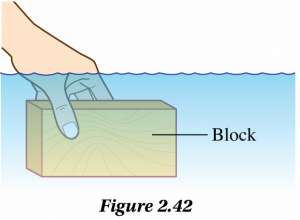Question 1:
State Archimedes’ principle.
Answer:
Archimedes’ principle states that an object which is partially or fully immersed in a fluid will experience a buoyant force equal to the weight of fluid displaced.
State Archimedes’ principle.
Answer:
Archimedes’ principle states that an object which is partially or fully immersed in a fluid will experience a buoyant force equal to the weight of fluid displaced.
Question 2:
A small boat displaces 3.8 × 10–2 m3 of sea water. Calculate the buoyant force acting on the boat.
[Density of sea water, ρ = 1 050 kg m–3 and gravitational acceleration, g = 9.81 m s–2]
Answer:
$$ \begin{aligned} & V=3.8 \times 10^{-2} \mathrm{~m}^3 \\ & F=? \\ & \rho=1050 \mathrm{~kg} \mathrm{~m}^{-3} \\ & g=9.81 \mathrm{~m} \mathrm{~s}^{-2} \end{aligned} $$
$$ \begin{aligned} &\text { Buoyant force, }\\ &\begin{aligned} & F_B=\rho V g \\ & =(1050) \times\left(3.8 \times 10^{-2}\right) \times(9.81) \\ & =391.4 \mathrm{~N} \end{aligned} \end{aligned} $$
A small boat displaces 3.8 × 10–2 m3 of sea water. Calculate the buoyant force acting on the boat.
[Density of sea water, ρ = 1 050 kg m–3 and gravitational acceleration, g = 9.81 m s–2]
Answer:
$$ \begin{aligned} & V=3.8 \times 10^{-2} \mathrm{~m}^3 \\ & F=? \\ & \rho=1050 \mathrm{~kg} \mathrm{~m}^{-3} \\ & g=9.81 \mathrm{~m} \mathrm{~s}^{-2} \end{aligned} $$
$$ \begin{aligned} &\text { Buoyant force, }\\ &\begin{aligned} & F_B=\rho V g \\ & =(1050) \times\left(3.8 \times 10^{-2}\right) \times(9.81) \\ & =391.4 \mathrm{~N} \end{aligned} \end{aligned} $$
Question 3:

Figure 2.42 shows a block of mass 0.48 kg and volume 5.0 × 10–4 m3 being held in water. The density of water is 1 000 kg m–3. Determine the movement of the block when it is released.
[Density of water, ρ = 1 000 kg m–3 and gravitational acceleration, g = 9.81 m s–2]
Answer:
$$ \begin{aligned} &m=0.48 \mathrm{~kg}\\ &\begin{aligned} & V=5.0 \times 10^{-4} \mathrm{~m}^3 \\ & \rho=1000 \mathrm{~kg} \mathrm{~m}^{-3} \\ & g=9.81 \mathrm{~m} \mathrm{~s}^{-2} \end{aligned} \end{aligned} $$
$$ \begin{aligned} &\text { Weight of block }\\ &\begin{aligned} & =m g \\ & =(0.48) \times(9.81) \\ & =4.71 \mathrm{~N} \end{aligned} \end{aligned} $$
$$ \begin{aligned} & \text { Buoyant force, } \\ & F_B=\rho V g \\ & =(1000) \times\left(5.0 \times 10^{-4}\right) \times(9.81) \\ & =4.91 \mathrm{~N} \end{aligned} $$
Buoyant force > Weight of block
The block will move up with an acceleration.

Figure 2.42 shows a block of mass 0.48 kg and volume 5.0 × 10–4 m3 being held in water. The density of water is 1 000 kg m–3. Determine the movement of the block when it is released.
[Density of water, ρ = 1 000 kg m–3 and gravitational acceleration, g = 9.81 m s–2]
Answer:
$$ \begin{aligned} &m=0.48 \mathrm{~kg}\\ &\begin{aligned} & V=5.0 \times 10^{-4} \mathrm{~m}^3 \\ & \rho=1000 \mathrm{~kg} \mathrm{~m}^{-3} \\ & g=9.81 \mathrm{~m} \mathrm{~s}^{-2} \end{aligned} \end{aligned} $$
$$ \begin{aligned} &\text { Weight of block }\\ &\begin{aligned} & =m g \\ & =(0.48) \times(9.81) \\ & =4.71 \mathrm{~N} \end{aligned} \end{aligned} $$
$$ \begin{aligned} & \text { Buoyant force, } \\ & F_B=\rho V g \\ & =(1000) \times\left(5.0 \times 10^{-4}\right) \times(9.81) \\ & =4.91 \mathrm{~N} \end{aligned} $$
Buoyant force > Weight of block
The block will move up with an acceleration.
